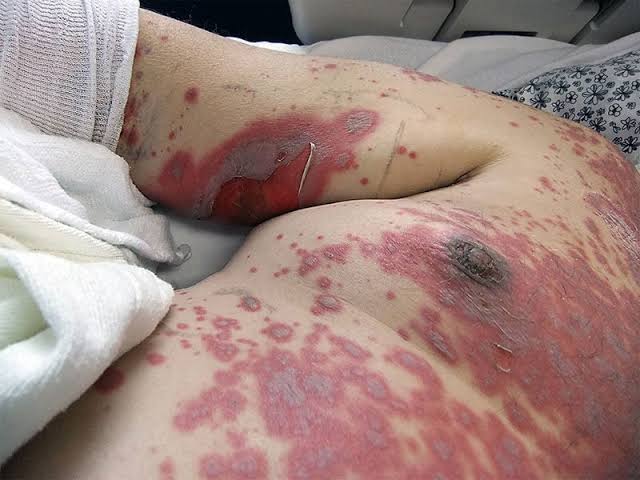Angioedema;

What is Angioedema?
Angioedema, characterized by non-pitting edema affecting subcutaneous and/or submucosal tissues, poses a threat when it involves critical areas such as the larynx. It encompasses swelling in various regions including the face, lips, neck, extremities, oral cavity, larynx, and gut.
Causes of Angioedema
Angioedema can stem from diverse origins, including:
- Allergic reactions triggering histaminergic angioedema associated with anaphylaxis.
- Non-allergic manifestations, either isolated or concurrent with urticaria.
- Drug-induced instances, such as those linked with angiotensin-converting enzyme inhibitors and non-steroidal anti-inflammatory drugs.
- Complement-mediated occurrences resulting from acquired deficiencies in C1-inhibitor.
- Idiopathic forms further divided into histaminergic and non-histaminergic categories.
- Hereditary variations, notably C1-Inhibitor deficiency, typified by type 1 and type 2 distinctions.
Types of Angioedema:
There are mainly two types ; Acquired and Inherited
1. Acquired Angioedema:
a. Allergic (Histaminergic Angioedema)
- Associated with anaphylaxis.
b. Non-allergic (Non-histaminergic Angioedema)
- May present isolated or in combination with urticaria.
c. Drug-induced Angioedema
- Caused by medications such as angiotensin-converting enzyme inhibitors and non-steroidal anti-inflammatory drugs.
d. Complement-mediated Angioedema
- Secondary to acquired deficiency of C1-inhibitor.
e. Idiopathic Angioedema
- Subdivided into histaminergic and non-histaminergic types.
2. Hereditary Angioedema:
C1-Inhibitor Deficiency
- Type 1: Lack of C1-inhibitor molecule.
- Type 2: Dysfunctional C1-inhibitor molecule with normal C1 inhibitor.
Signs and Symptoms:
1. Sudden Swelling:
- Swelling occurs suddenly, often in the face, lips, tongue, throat, or genitals.
- It may also affect the hands, feet, or other body parts.
2. Pain and Discomfort:
- Swelling is usually accompanied by pain, discomfort, or a burning sensation.
- It can cause tightness or difficulty breathing if it affects the throat.
3. Skin Changes:
- Affected areas may appear red, warm, or tender to the touch.
- Skin may feel stretched or taut due to the swelling beneath the surface.
4. Rapid Onset:
- Symptoms typically develop rapidly, within minutes to hours.
- The swelling may worsen over several hours before gradually subsiding.
5. Recurrence:
- Episodes of angioedema can recur intermittently over time.
- Some individuals may experience frequent episodes, while others may have long periods without symptoms.
6. Associated Symptoms:
- Itching or tingling sensation in the affected area.
- Swelling may be accompanied by hives (urticaria) or other allergic reactions.
7. Potential Complications:
- Difficulty breathing or swallowing if swelling affects the throat.
- Severe cases can lead to anaphylaxis, a life-threatening allergic reaction.
- Angioedema associated with hereditary or acquired causes may be accompanied by symptoms specific to the underlying condition.
8. Duration:
- Swelling typically resolves within 24 to 48 hours, but may persist longer in some cases.
- Chronic forms of angioedema may have persistent or recurring symptoms over an extended period.
9. Trigger Factors:
- Certain triggers, such as allergens, medications, infections, or stress, may precipitate angioedema episodes.
- Identifying and avoiding triggers can help prevent or reduce the frequency of episodes in some individuals.
Treatment:
Treatment of Angioedema
1. Immediate Intervention:
- Medications:
- Administer antihistamines promptly to reduce swelling and itching.
- Consider corticosteroids for their anti-inflammatory effects, especially in severe cases.
- In emergency situations or if airway compromise is suspected, administer epinephrine promptly.
2. Airway Management:
- Assessment:
- Evaluate the airway for any signs of obstruction or compromise.
- Intervention:
- Ensure a clear airway through proper positioning.
- Consider intubation or emergency tracheostomy if necessary to maintain airway patency.
3. Supportive Measures:
- Cold Compresses:
- Apply cold compresses to the affected area to alleviate swelling and discomfort.
- Elevation:
- Elevate the affected area, if feasible, to reduce swelling and promote drainage.
4. Identification and Avoidance of Triggers:
- Trigger Assessment:
- Investigate potential triggers such as foods, medications, or environmental factors.
- Trigger Avoidance:
- Educate the patient on avoiding known triggers to prevent future episodes.
5. Management of Underlying Conditions:
- Underlying Cause Investigation:
- Conduct a thorough evaluation to identify any underlying health conditions or contributing factors.
- Treatment Plan:
- Develop a treatment strategy tailored to address the underlying cause, which may include managing autoimmune diseases, addressing hormonal imbalances, or adjusting medications.
6. Emergency Preparedness:
- Emergency Action Plan:
- Establish an emergency action plan for individuals at risk of severe angioedema or anaphylaxis.
- Ensure access to emergency medications, such as epinephrine auto-injectors, and educate the patient and caregivers on their proper use.
Read Another Article:
- Health Benefits of aparajita
- Health Benefits of Vitamin C
- Antihistamines

